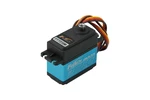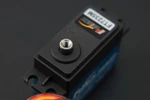








High Torque Waterproof Metal Coreless Digital Servo (35KG, 180°, IP54)
- $25.00 3+ items
- $24.50 5+ items
- $24.00 10+ items
Introduction
This is a high-torque waterproof coreless digital servo with a robust metal construction. It boasts an impressive torque of 35kg, allowing for precise control within a 180-degree range. With improved linear motion, it features an internal gear system made of reinforced steel gears with an optimized center distance of 2.0, enhancing its performance. The servo incorporates a dual ball bearing design and utilizes a hollow-cup motor for enhanced heat dissipation and extended lifespan.

Furthermore, the servo comes equipped with overload protection, ensuring a safer operation. When the servo stalls, the output torque exceeds the overload torque and remains at an elevated level for over 8 seconds, after which the current drops by 80%.

To enhance its water resistance, the servo's joints are fortified with waterproof gaskets, and the circuit board is coated with a waterproof varnish. Both the motor and the potentiometer are sealed with a specialized adhesive. These measures contribute to the servo's exceptional waterproof capabilities. Moreover, this servo is accompanied by a selection of different-shaped servo horns, enabling its application in a wider range of environments.

The Principle of Coreless Servo
The characteristic of a hollow cup servo is that its motor rotor is an extremely lightweight, poleless, hollow rotor, with magnets placed inside the cylinder, which is the hollow cup motor. The output power of the hollow cup servo is proportional to the distance it needs to rotate. If the output shaft needs to rotate a long distance, the control circuit will send a power pulse of maximum width to make the motor run at full speed; if it only needs to rotate a short distance, the motor will run at a slower speed.

Interface Definition Diagram


Dimensional Diagram
Applications
Specification
Electrical characteristics
Control characteristics
Mechanical specifications
Other parameters











